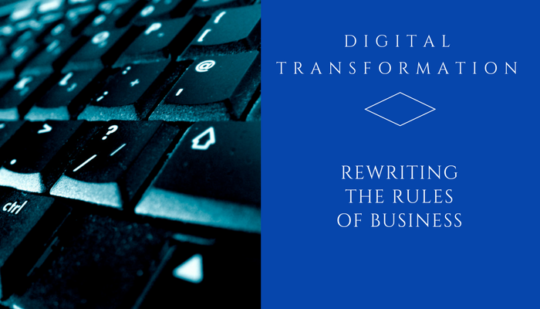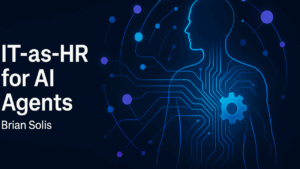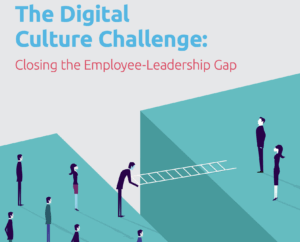We live in an era of digital Darwinism. As customer expectations evolve and move toward personalized experiences and beyond transactions, companies in every industry must focus digital transformation on not only digital, but also people, purpose, and relevance.
Digital transformation has become an absolute must-have to secure future growth, improve customer experience and loyalty as well as operational efficiency. Along with it, digital transformation also represents an opportunity to rewrite the rules of business?
I got to spend some time with Kofax and CMO Grant Johnson in Nashville recently at the company’s Inspire event for customers and employees. We had the pleasure of sharing our vision for the future and what it takes to get there. After each of our respective presentations, we met up again, this time in a private room, to talk about the future of digital transformation, customer experience, and technology. Thankfully there were cameras and someone taking notes so we were able to capture and share our conversation. We hope it helps you.
Grant: One of the major challenges for organizations in digital transformation is: where do they start? They need a plan to create the organizational readiness for change. Where is digital transformation heading and what can organizations do about it?
Brian: In my research, I found that digital transformation is often something that starts in any pocket of the organization. It can start from anywhere for any reason. Most often I had found that CMOs were kicking off a lot of very interesting digital transformation projects as a way of trying to get in front of the digital customer. And in learning that the digital customer was so different than the traditional customer, they had to make a lot of investments in new technologies, but also supporting processes, and systems and policies to try to implement new things that were so different.
At the same time, I’ve seen IT and the CIO lead a lot of digital transformation initiatives as a way of just shifting infrastructure to the Cloud and mobile, etc. But I’ve also seen some of the most obscure places for digital transformation. Human Resources, for example, having challenges in attracting millennial talent and going through the whole employee prospect journey realizing, “Wow, our forms and surveys don’t even load on mobile phones. We have to rethink this whole thing.”
Grant: What’s the key catalyst to getting organizations to do something?
Brian: The most successful digital transformation implementations I’ve seen have been when digital transformation has a purpose. What are we trying to do and why? Whether it’s trying to get in front of the digital customer, or the employee, it has to have a reason. People have to have something within the organization to rally behind. Otherwise, it just becomes a technology story. The most successful digital transformation implementations I’ve seen have been when digital transformation has a purpose. What are we trying to do and why? Whether it’s trying to get in front of the digital customer, or the employee, it has to have a reason. People have to have something within the organization to rally behind. Otherwise, it just becomes a technology story.
You can’t hand off any aspect of the customer experience anymore because they’re too connected. They’re too sophisticated. They’re too informed, and they have a different set of expectations. From a cross-functional standpoint, you have an opportunity to actually re-imagine the infrastructure of how a business operates, and I think that’s what I’m so excited about, that digital transformation might start as one thing, but end up changing the entire business as a result.
Grant: If you don’t serve the customer, someone else will. So you need to figure out how to get your organization behind the mandate of digital transformation. What doesn’t resonate with customers today? What doesn’t work?
Brian: We found 90% of people when they go to make a purchase decision, reach for their mobile device and have zero brand interest when they go to make that decision. They’re simply using the phone to ask a question and then the journey begins. It’s the opposite of what we’ve thought with the traditional funnel. And then 73% will make a decision with the company that was most useful in those, what they call micro-moments. And it’s interesting because what they define as useful was, “Was I able to get the information I needed in this moment, on this device, in a way that’s intuitive to how I use the device?” And most companies are not ready for that.
Grant: Right at the moment, where it matters the most. You call it micro moments. We’ve called it mobile moments. That’s where customers want everything to happen. What’s the gap between what the customers are demanding and what companies are able to provide?
Brian: This is why I spend a lot of time in social science. There’s no easy answer to this question. I don’t think that any executive will say, “Hey Brian, let me tell you a secret. We don’t really care about our customers.” But they don’t act like they care about their customers.
There’s just a big disconnect in executives and also shareholders and the board are equally guilty. They look at all of this stuff as cost centers, when in fact, I look at them as investments in the future of the organization. Not just the health but the ability to compete in a digital economy that’s constantly evolving. So it’s a mindset, it really is just a mindset, they do not see this as an opportunity that they jump in with both feet and say, “Let’s do this, let’s do this now, whatever it takes to compete.” Because it’s pushing against so many norms and so many conventions that it’s easier not to do those things.
Grant: I often will say to executives “What does it cost if we don’t do it? It’s going to cost more, right?”
Brian: “What’s the ROI of the “I” stands for ignorance?” When you look at customer experience as an investment opportunity, you could actually tie real numbers to this. There are customers that you’re actually not reaching today simply because you are not part of the decision-making cycle. So what if you were? What would that look like to transcend investments into the return? The best change agents are a handful of things. Find out what and who these change agents are.
Grant: What do you see as the model for somebody seizing hold of trying to change the company? How do they build that momentum?
Brian: Change is about people. Digital transformation is about change, right? So it really does come down to people. A lot of this is psychological. Change agents, some of them are reluctant change agents, some of them are type “A” personalities and they just go for it and they just barrel through doors. But I think the most common thing that they all share is that it’s just hard to change people’s minds. And what this really is about is changing people’s minds without telling them they have to change their minds, because that puts people on the defensive. What we’re really talking about doing is getting people to see that this is an opportunity of which they can play a role in. So everybody has a role in digital transformation.
Please watch the entire interview with Grant Johnson.
About Brian
Brian Solis is principal analyst and futurist at Altimeter, the digital analyst group at Prophet, Brian is world renowned keynote speaker and 7x best-selling author. His latest book, X: Where Business Meets Design, explores the future of brand and customer engagement through experience design. Invite him to speak at your event or bring him in to inspire and change executive mindsets.
Connect with Brian!
Twitter: @briansolis
Facebook: TheBrianSolis
LinkedIn: BrianSolis
Instagram: BrianSolis
Youtube: BrianSolisTV
Snapchat: BrianSolis






Great article. You might want to remove the duplicate paragraph. 🙂
I think it is important to use vocabulary that suits you the most. I would switch the term ‘change’ into ‘constant improvement’. Somehow, it is easier for me to improve rather than change;)
Sounds like a good idea!